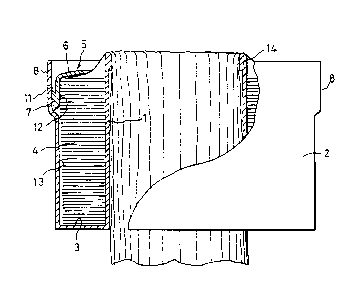Some of the information on this Web page has been provided by external sources. The Government of Canada is not responsible for the accuracy, reliability or currency of the information supplied by external sources. Users wishing to rely upon this information should consult directly with the source of the information. Content provided by external sources is not subject to official languages, privacy and accessibility requirements.
Any discrepancies in the text and image of the Claims and Abstract are due to differing posting times. Text of the Claims and Abstract are posted:
| (12) Patent: | (11) CA 1318234 |
|---|---|
| (21) Application Number: | 1318234 |
| (54) English Title: | CASSETTE CONTAINING FLEXIBLE TUBING TO BE DISPENSED THEREFROM |
| (54) French Title: | CASSETTE DE DISTRIBUTION DE TUYAU SOUPLE |
| Status: | Expired and beyond the Period of Reversal |
| (51) International Patent Classification (IPC): |
|
|---|---|
| (72) Inventors : |
|
| (73) Owners : |
|
| (71) Applicants : |
|
| (74) Agent: | SMART & BIGGAR LP |
| (74) Associate agent: | |
| (45) Issued: | 1993-05-25 |
| (22) Filed Date: | 1989-07-31 |
| Availability of licence: | N/A |
| Dedicated to the Public: | N/A |
| (25) Language of filing: | English |
| Patent Cooperation Treaty (PCT): | No |
|---|
| (30) Application Priority Data: | ||||||
|---|---|---|---|---|---|---|
|
A CASSETTE CONTAINING FLEXIBLE TUBING
TO BE DISPENSED THEREFROM
In a cassette for dispensing flexible tubing, the
tubing is packed in a tightly layered mass between a
tubular core and the vertical wall of a casing.
Subsequently a cap is mounted in an expanded portion of
the casing. The cap has A vertical part fitting the
portion and a flange partially overlapping the pack. The
cap is secured against rising by punching tongues out of
the portion that engage in a groove in the part. The
inner surface of part aligns with surface of casing. The
junction beneath expanded portion prevents cap from
descending as the tubing is dispensed from the top of the
pack, over the core edge and through core.
Note: Claims are shown in the official language in which they were submitted.
Note: Descriptions are shown in the official language in which they were submitted.

2024-08-01:As part of the Next Generation Patents (NGP) transition, the Canadian Patents Database (CPD) now contains a more detailed Event History, which replicates the Event Log of our new back-office solution.
Please note that "Inactive:" events refers to events no longer in use in our new back-office solution.
For a clearer understanding of the status of the application/patent presented on this page, the site Disclaimer , as well as the definitions for Patent , Event History , Maintenance Fee and Payment History should be consulted.
| Description | Date |
|---|---|
| Inactive: Reversal of expired status | 2012-12-05 |
| Time Limit for Reversal Expired | 2010-05-25 |
| Letter Sent | 2009-05-25 |
| Grant by Issuance | 1993-05-25 |
There is no abandonment history.
| Fee Type | Anniversary Year | Due Date | Paid Date |
|---|---|---|---|
| MF (category 1, 5th anniv.) - standard | 1998-05-25 | 1998-04-14 | |
| MF (category 1, 6th anniv.) - standard | 1999-05-25 | 1999-04-14 | |
| MF (category 1, 7th anniv.) - standard | 2000-05-25 | 2000-04-13 | |
| MF (category 1, 8th anniv.) - standard | 2001-05-25 | 2001-04-17 | |
| MF (category 1, 9th anniv.) - standard | 2002-05-27 | 2002-04-16 | |
| MF (category 1, 10th anniv.) - standard | 2003-05-26 | 2003-04-16 | |
| MF (category 1, 11th anniv.) - standard | 2004-05-25 | 2004-04-13 | |
| MF (category 1, 12th anniv.) - standard | 2005-05-25 | 2005-04-13 | |
| MF (category 1, 13th anniv.) - standard | 2006-05-25 | 2006-04-13 | |
| MF (category 1, 14th anniv.) - standard | 2007-05-25 | 2007-05-17 | |
| MF (category 1, 15th anniv.) - standard | 2008-05-26 | 2008-04-16 |
Note: Records showing the ownership history in alphabetical order.
| Current Owners on Record |
|---|
| MELROSE PRODUCTS LIMITED |
| Past Owners on Record |
|---|
| BRIAN WARD |
| DAVID CHARLES RICHARDS |
| MAURICE STANLEY WILLIAMS |